Inside Oracle9i Tablespace Management
Over the past few releases Oracle has been automating and improving the internal administration of tables and indexes. It has gradually recognized the benefits of bitmap data structures in all areas of the database. Recently, Oracle has introduced two new tablespace parameters that automate storage management functions:
- LMT (Locally Managed Tablespaces) — The LMT tablespace is implemented by adding EXTENT MANAGEMENT LOCAL clause to the tablespace definition. LMT tablespaces automate extent management and remove the ability to specify the NEXT storage parameter. The only exception is when NEXT is used with MINEXTENTS at table creation time.
- ASSM (Automatic Segment Space Management) — The ASSM tablespace is implemented by adding the SEGMENT SPACE MANAGEMENT AUTO clause to the tablespace definition. ASSM tablespaces automate FREELIST management and remove the ability to specify PCTUSED, FREELISTS, and FREELIST GROUPS storage parameters. You cannot use ASSM unless you also use LMTs on a tablespace.
It is important to note that LMT and ASSM are optional and are used in the same instance with "traditional" tablespaces. Remember, LMT and ASSM are implemented at the tablespace level and each instance can have LMT, LMT and ASSM tablespaces, or traditional tablespaces.
Before we discuss the differences between bitmap FREELISTS and traditional FREELIST management, let's examine how bitmap FREELISTS are implemented. We begin by creating a tablespace with the segment space management auto parameter. Note that ASSM is only valid for locally-managed tablespaces with extent management local syntax.
create tablespace
asm_test
datafile
'c:\oracle\oradata\diogenes\asm_test.dbf'
size
5m
EXTENT MANAGEMENT LOCAL
SEGMENT SPACE MANAGEMENT AUTO
;
Once a table or index is allocated in this tablespace, the values for PCTUSED for individual objects will be ignored, and Oracle9i will automatically manage the FREELISTS for the tables and indexes inside the tablespace. For objects created in this tablespace, the NEXT extent clause is now obsolete because of the locally-managed tablespace (except when a table is created with MINEXTENTS and NEXT). The INITIAL parameter is still required because Oracle cannot know in advance the size of the initial table load. When using Automatic Space Management, the minimum value for INITIAL is three blocks.
There is some debate about whether a one-size-fits-all approach is best for Oracle. In large databases, individual object settings can make a huge difference in both performance and storage. As we may know, the setting for PCTUSED governs FREELIST re-linking. If we want high disk space usage, we set PCTUSED to a value xzignthly greater than avg_row_len. Conversely, if we want fast INSERT performance, we set PCTUSED to a low value, ensuring that all free blocks are nearly empty, providing lots of block space for INSERT operations.
The Issue of PCTFREE
As a quick review, the PCTFREE parameter is used to specify the amount of free space on a data block to reserve for future row expansion. If PCTFREE is set improperly, SQL update statements can cause a huge amount of row fragmentation and chaining.
The setting for PCTFREE is especially important where a row is initially stored small and expanded at a later time. In such systems, it is not uncommon to set PCTFREE equal to 95, telling Oracle to reserve 95 percent of the data block space for subsequent row expansion.
Fortunately, Oracle9i does not allow you to specify the value for PCTFREE if you are using Automatic Space Management. Row chaining is a serious problem for the DBA, and it appears that Automatic Space Management is still appropriate for tables for which you need to reserve space for large row expansions with PCTFREE.
The Issue of PCTUSED
As we know, improper settings for PCTUSED can cause huge degradation in the performance of SQL inserts. If a data block is not largely empty, excessive I/O will happen during SQL inserts because the re-used Oracle data blocks will become full quickly. Taken to the extreme, improper settings for PCTUSED can create a situation in which the free space on the data block is smaller than the average row length for the table. In these cases, Oracle will try five times to fetch a block from the FREELIST chain. After five attempts, Oracle will raise the high-water mark for the table and grab five fresh data blocks for the insert.
In Oracle9i with Automatic Segment Management, the PCTUSED parameter no longer governs the re-link threshold for a table data block, and we must rely on the judgment of Oracle to determine when a block is empty enough to be placed onto the FREELIST.
Unlike PCTFREE, in which Oracle cannot tell in advance how much row expansion will occur, Oracle9i does have information about the right time to re-link a data block. Because Oracle knows the average row length for the table rows (dba_tables.avg_row_Len), Oracle should be able to adjust PCTUSED to ensure that the re-linked data block will have room for new rows.
An Oracle Inconsistency
While Oracle9i ignores the PCTUSED, FREELISTS, and FREELIST GROUPS parameters with LMT and ASSM tablespaces, Oracle does not give an error message when these "ignored" parameters are used in a table definition.
SQL> create table
2 test_table
3 (c1 number)
4 tablespace
5 asm_test
6 pctfree 20 pctused 30
7 storage
8 ( freelists 23 next 5m ) ;Table created.
Most Oracle DBAs would assume that invalid parameters would be treated as they have been treated since Oracle7, and reported as an error.
SQL> create index
2 test_type_idx
3 on
4 book(book_type)
5 PCTUSED 40 ;
PCTUSED 40
*
ERROR at line 5:
ORA-02158: invalid CREATE INDEX option
This could lead to confusion when a DBA believes that they are changing these values when in reality, tablespaces with LMT or SAM ignore any specified values for PCTUSED, NEXT, and FREELISTS.
No More Buffer Busy Waits
One huge benefit of Automatic Segment Management is the bitmap FREELISTS that are guaranteed to reduce buffer busy waits. Let's take a close look at this feature.
Prior to Oracle9i, buffer busy waits were a major issue. As a review, a buffer busy wait occurs when a data block is inside the data buffer cache, but it is unavailable because it is locked by another DML transaction. A block was unavailable because another SQL insert statement needed to get a block on which to place its row. Without multiple FREELISTS, every Oracle table and index had a single data block at the head of the table to manage the free block for the object. Whenever any SQL insert ran, it had to go to this block and get a data block on which to place its row.
Obviously, single FREELISTS cause a backup. When multiple tasks wanted to insert into the same table, they were forced to wait while Oracle assigned free blocks, one at a time.
Oracle's Automatic Segment Space Management feature claims to improve the performance of concurrent DML operations significantly since different parts of the bitmap can be used, simultaneously eliminating serialization for free space lookups.
According to Oracle benchmarks, using bitmap FREELISTS removes all segment header contention and allows for super-fast concurrent insert operations (refer to figure 1).
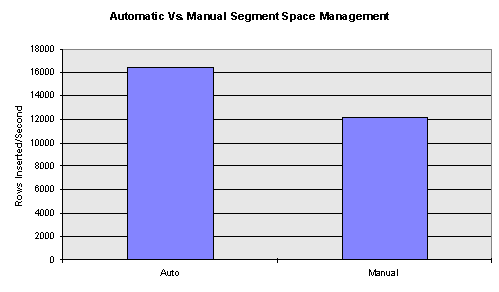
Figure 1: Oracle Corporation benchmark on SQL insert speed with bitmap FREELISTS.
Along with the Automatic Segment Management features, we get some new tools for the DBA. Let's take a look at how the Oracle9i DBA will use these tools.
Internal Freelist Management
With ASSM, Oracle controls the number of bitmap FREELISTS, ups to 23 per segment.
Internally within Oracle, a shortage of FREELISTS is manifested by a buffer busy wait. This is because the segment header is available in the data cache, but the block cannot be accessed because another task has locked the block to INSERT, DELETE, or UPDATE a row. Oracle9i may have a mechanism to allocate a new segment header block (with another bitmap FREELIST) whenever buffer busy waits are detected for the segment. As we may know, Oracle introduced dynamic FREELIST addition in Oracle8i.
Freelist Unlinks
While it is possible for Oracle9i to detect the average row length for segments in a bitmap managed tablespace, Oracle9i has no way of predicting how much space to reserve of each data block for row expansion. This is because Oracle9i has no knowledge of VARCHAR datatypes that may later be expanded with SQL UPDATE statements. Logic dictates that Oracle9i must examine the updated row length for every UPDATE and relocate the row if it would chain onto another data block if left on its target block. Row relocation can have a high overhead, especially for batch-oriented SQL updates.
Freelist Relinks
For Oracle to optimize the threshold for relinking a data block, it needs a priori knowledge of the volume of subsequent INSERT statements. If the threshold is set too high, only a small amount of space is reserved on the relinked data block, and only a few rows can be INSERTED before Oracle is forced to perform an I/O to grab another data block. Of course, Oracle9i could detect high-volume INSERTS and use the APPEND option to bypass the FREELISTS and use empty table blocks for subsequent inserts.
Characteristics of Bitmap Segment Management
Bitmap space management uses four bits inside each data block header to indicate the amount of available space in the data block. Unlike traditional space management with a fixed relink and unlink threshold, bitmap space managements allow Oracle to compare the actual row space for an INSERT with the actual available space on the data block. This enables better reuse of the available free space especially for objects with rows of highly varying size. Here are the values inside the four-bit space:
| Value | Meaning |
| 0000 | Unformatted Block |
| 0001 | Block is logically full |
| 0010 | <25% free space |
| 0011 | >25% but <50% free space |
| 0100 | > 50% but <75% free space |
| 0101 | >75% free space |
Table 1: Bitmap value meanings.
The value of this bitmap indicates how much free space exists in a given data block. In traditional space management, each data block must be read from the FREELIST to see if it has enough space to accept a new row. In Oracle9i, the bitmap is constantly kept up-to-date with changes to the block, and reducing wasted space because blocks can be kept fuller since the overhead of FREELIST processing has been reduced.
Another enhancement of Oracle9i space management is that concurrent DML operations improve significantly. This is because different parts of the bitmap can be used simultaneously, thereby eliminating the need to serialize free space lookups.
Please note that Oracle9i segment control structures are much larger than traditional FREELIST management. Because each data block entry contains the four-byte data block address and the four-bit free space indicator, each data block entry in the space management bitmap will consume approximately six bytes of storage.
It is also important to note that space management blocks are not required to be the first blocks in the segment. In Oracle8, the segment headers were required to be the first blocks in the segment. In Oracle8i this restriction was lifted, and the DBA could allocate additional FREELISTS with the ALTER TABLE command. In Oracle9i, Oracle automatically allocates new space management blocks when a new extent is created and maintains internal pointers to the bitmap blocks (refer to figure 2).
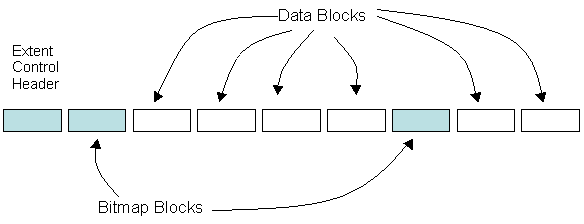
Figure 2: Non-contiguous bitmap blocks within a segment.
Oracle9i Freelist Internals
Just like traditional FREELISTS, the bitmap block (BMB) is stored in a separate data block within the table or index. Because Oracle does not publish the internals of space management, we must infer the structure from block dumps. Hence, this information may not be completely accurate, but it will give us a general idea about the internal mechanisms of Oracle9i automatic space management.
Unlike a linear-linked list in traditional FREELISTS, bitmap blocks are stored in a B-tree structure, much like a B-tree index structure. This new structure has important ramifications for concurrent DML. In traditional FREELISTS, free blocks must be accessed one at a time, and this causes segment header contention in applications with high-volume INSERT operations. Because Oracle9i can use the FREELISTS blocks much like a B-tree index, multiple transactions can simultaneously access free blocks without locking or concurrency problems.
Now let's look inside the segment header and take a closer look at the bitmap space management techniques.
Segment Extent Control Header
As we have noted, the purpose of bitmap blocks are to track the free blocks in the segment. Since the free blocks are organized in a B-tree, we see the following nodes inside the segment control block. There are three data blocks that comprise the segment control.
The extent control header block contains the following components:
- The extent map of the segment
- The "last" block at each level of the B-tree
- The low high-water mark
- The high high-water mark
- First-level bitmap block, which contains a list of all first-level data block addresses, and the four-bit free space indicator for each block
- Second-level bitmap block, which contains a list of all second-level data block addresses, and the four-bit free space indicator for each block
New High-Water Mark Pointers
The high-water mark in the segment header has also changed in Oracle9i bitmap blocks. Instead of having a single pointer to the highest free block in an object, the B-tree index structure allows for a range of high-water mark blocks. Hence, we see two pointers for the high-water mark.
- The low high-water mark (LHWM) — All blocks below this block have been formatted for the table.
- The high high-water mark (HHWM) — All blocks above this block have not been formatted. Internally, the HHWM is required to ensure that Oracle direct load operations can access contiguous unformatted blocks.
As we see in figure 3, Oracle9i maintains several sets of pointers to bitmap blocks in the segment header.
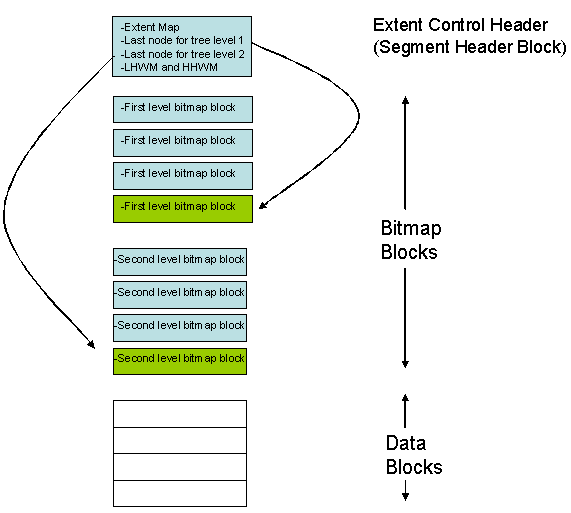
Figure 3: Segment header pointers to bitmap blocks.
Let's look at each block in detail to understand how space is managed in bitmap segment control.
Extent Control Header Block
This block contains the high high-water mark, the low high-water mark, the extent map, and the data block addresses for each of the three levels of bitmap blocks.
The extent map lists all of the data block address for each block within each extent within the segment and shows the four-bit free space of each block within the extent. Since the extent size is controlled by Oracle9i locally-managed tablespaces, each extent size within the tablespace is uniform, regardless of the NEXT extent size for each object in the tablespace.
Note that the first three blocks of the first extend list (blocks 0 — 2) are used for metadata and are not available for segment block addresses.
For each extent in the segment, Oracle9i keeps an entry pointing to the bitmap for that segment (refer to figure 4).
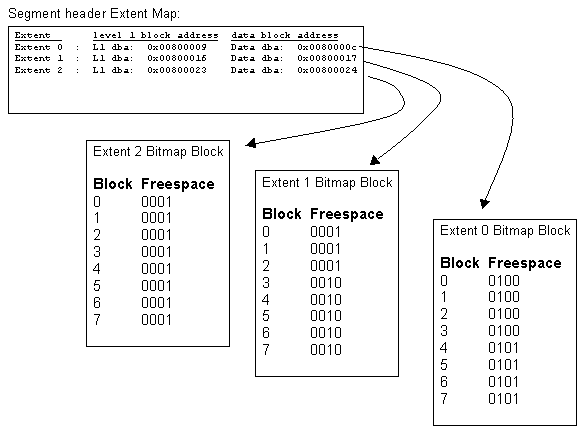
Figure 4: Segment header extent map points to all extent bitmaps in segments.
Oracle9i also has pointers to the last bitmap block within each logical bitmap level (refer to figure 5).
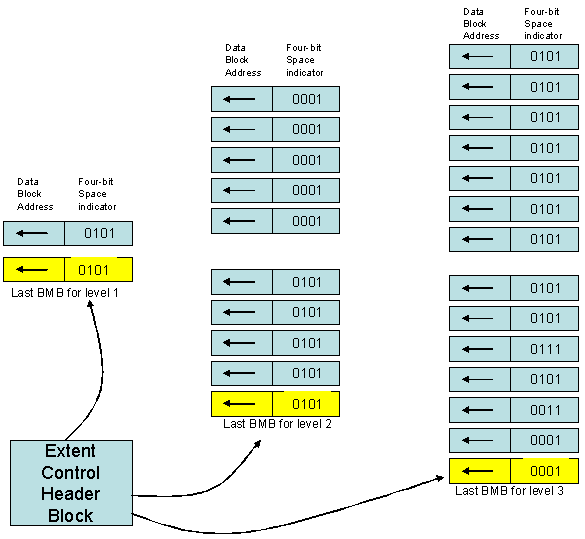
Figure 5: Pointers to last bitmap block on each bitmap level.
This new pointer structure allows Oracle9i to quickly access multiple bitmaps to improve concurrency of high-volume INSERTs.
Potential Performance Issues with ASSM
The Oracle9i community has mixed feelings about using ASSM tablespaces. Among the top points about ASSM, we find both Pros and Cons:
Pros of ASSM:
- Varying row sizes — ASSM is better than a static PCTUSED. The bitmaps make ASSM tablespaces better at handling rows with wide variations in row length.
- Reducing buffer busy waits — ASSM will remove buffer busy waits better than using multiple FREELISTS. As we may know, when a table has multiple FREELISTS, all purges must be parallelized to reload the FREELISTS evenly, and ASSM has no such limitation.
- Great for RAC — The bitmap FREELISTS remove the need to define multiple FREELISTS groups for RAC, and provide overall improved FREELIST management over traditional FREELISTS.
Cons of ASSM:
- Slow for full-table scans — Several studies have shown that large-table full-table scans (FTS) will run longer with ASSM than standard bitmaps. ASSM-FTS tablespaces are consistently slower than Freelist-FTS operations. This implies that ASSM may not be appropriate for decision support systems and warehouse applications, unless partitioning is used with Oracle Parallel Query.
- Slower for high-volume concurrent INSERTS — Numerous experts have conducted studies that show that tables with high volume bulk loads perform faster with traditional multiple FREELISTS.
- ASSM will influence index clustering — For row-ordered tables, ASSM can adversely affect the clustering_factor for indexes. Bitmap FREELISTS are less likely to place adjacent tows on physically adjacent data blocks, and this can lower the clustering_factor, and the cost-based optimizer's propensity to favor an index range scan.
Conclusion
The combination of bitmap FREELISTS (automatic segment space management) and Locally Managed Tablespaces has greatly simplified and improved the internal management of data blocks within Oracle tablespaces. The use of bitmap FREELISTS removes the need to define multiple FREELISTS for tables and indexes that experience high-volume concurrent DML, and provides a simple solution to the problem of segment header contention.
However, the savvy DBA recognizes the tradeoff between one-size-fits-all convenience and the power of being able to set individual object parameters for tables and indexes. The choice of LMT and ASSM for tablespace management depends heavily on the application, and real-world Oracle9i tablespaces will implement LMT and ASSM tablespaces only after careful consideration.
--
Donald K. Burleson is one of the world's top Oracle database experts. He has written 14 books, published more than 100 articles in national magazines, and serves as editor-in-chief of Oracle Internals, a leading Oracle database journal. As a leading corporate database consultant, Don has worked with numerous Fortune 500 corporations creating robust database architectures for mission-critical systems. Don's Web sites are http://www.dba-oracle.com and http://www.remote-dba.net/.
Contributors : Donald K. Burleson
Last modified 2005-06-22 12:03 AM
